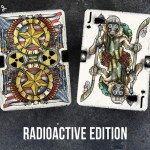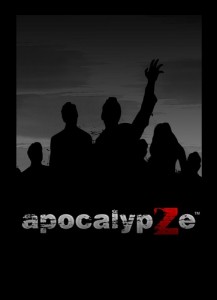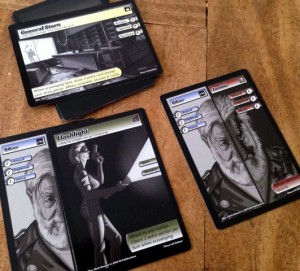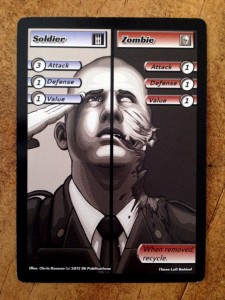Crowdfunding Highlights
07 Jul
Posted by Thomas Deeny as Card Games, Classic Board Games, Miniatures, Modern Board Games, RPGs
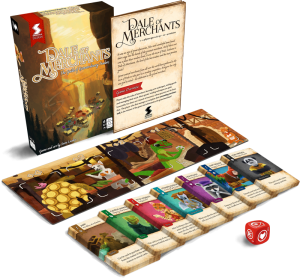 Reaper Miniatures launched their third Kickstarter campaign for their Bones miniature line this morning. The Texas-based company originally held their first campaign for the miniatures in August of 2012, raising nearly $3.5 million to fund the miniature molds and move production of the line from China to the United States. The first campaign’s Vampire level at $100 originally included 100 miniatures but stretch goals took that over 225 miniatures. (I still have only a third painted!) Bones 3 is only running for 18 days, ending on July 25th at 8 PM EDT.
Reaper Miniatures launched their third Kickstarter campaign for their Bones miniature line this morning. The Texas-based company originally held their first campaign for the miniatures in August of 2012, raising nearly $3.5 million to fund the miniature molds and move production of the line from China to the United States. The first campaign’s Vampire level at $100 originally included 100 miniatures but stretch goals took that over 225 miniatures. (I still have only a third painted!) Bones 3 is only running for 18 days, ending on July 25th at 8 PM EDT.
Dale of Merchants: The Guild of Extraordinary Traders by Snowdale Design (above) looks crazy cute. This deckbuilder has the players taking on the roles of animal (why? because.) merchants setting up stalls in a marketplace to showcase their wares and join the guild. The playthrough videos and artwork shared look fun (the campaign features a series of Rahdo Runs Through videos for you to check out). Game-level rewards start at $24. The campaign ends on July 31st.
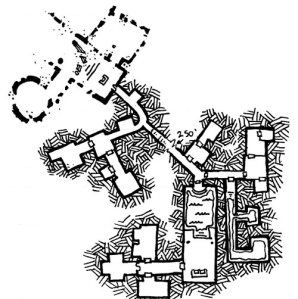 On Patreon, Dyson Logos is creating cartography for fantasy roleplaying games. With pledge levels starting as low as five cents, it’s easy to support this mapmaker. All of his maps are available for free at his blog, Dyson’s Dodecahedron, but pledging $1 per map or adventure gets you 300 dpi versions of the maps before they make it to the blog. A $5 per work pledge unlocks the PDF versions of any forthcoming book and the Dyson’s Delves I & II books. Dyson’s stuff is really fantastic. (Currently, the Patreon is just under $25 in pledges from unlocking another milestone: releasing the back catalog of maps under a commercial open-license.)
On Patreon, Dyson Logos is creating cartography for fantasy roleplaying games. With pledge levels starting as low as five cents, it’s easy to support this mapmaker. All of his maps are available for free at his blog, Dyson’s Dodecahedron, but pledging $1 per map or adventure gets you 300 dpi versions of the maps before they make it to the blog. A $5 per work pledge unlocks the PDF versions of any forthcoming book and the Dyson’s Delves I & II books. Dyson’s stuff is really fantastic. (Currently, the Patreon is just under $25 in pledges from unlocking another milestone: releasing the back catalog of maps under a commercial open-license.)
Oh man, I do love me some fantastic playing cards, and this month there’s some great-looking ones on Kickstarter. Let’s start with the Wasteland 2-inspired Wasteland Playing Cards, illustrated by Jackson Robinson. This has already blown past the funding goal and will be funded on July 31st. $12 for the basic deck of cards ready for the Apocalypse (seriously — I’d love to find a way to hack the Apocalypse World RPG to use this card set). Or perhaps you’re a fan of the golden age of piracy? Well, in that case, check out the Seven Seas Master Collection by Brain Vessel Creative. Pirates, sea creatures, and two different ship-themed decks await, with individual decks starting at $12.
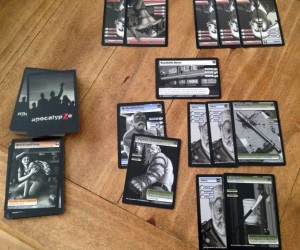 And look what I just stumbled across! 9 Kingdoms Publications are in their final days of a Kickstarter campaign to produce an expansion to ApocalypZe. (That’s the original game on the right.) You might recall a while back I reviewed the zombie survival card game (tl;dr: it’s pretty darn good). The original game came with pre-constructed decks and extra cards to build out your own deck. This expansion adds two more decks and six additional cards, and they’ve revisited the graphic design of the cards so they’re easier to read. In addition to the expansion, they also have booster packs to beef up your decks on offer. $25 gets you the expansion, the base game (plus the extra stuff from that game’s KS) is a $40 add-on. Or just go $75 for everything (base, expansion, and boosters).
And look what I just stumbled across! 9 Kingdoms Publications are in their final days of a Kickstarter campaign to produce an expansion to ApocalypZe. (That’s the original game on the right.) You might recall a while back I reviewed the zombie survival card game (tl;dr: it’s pretty darn good). The original game came with pre-constructed decks and extra cards to build out your own deck. This expansion adds two more decks and six additional cards, and they’ve revisited the graphic design of the cards so they’re easier to read. In addition to the expansion, they also have booster packs to beef up your decks on offer. $25 gets you the expansion, the base game (plus the extra stuff from that game’s KS) is a $40 add-on. Or just go $75 for everything (base, expansion, and boosters).
 ApocalypZe is a zombie survivor themed card game that plays from 2 to 4. Players manage a group of survivors at a mostly secure location, trying to manage the stronghold’s resources. Survive longer than your opponents and you win the game.
ApocalypZe is a zombie survivor themed card game that plays from 2 to 4. Players manage a group of survivors at a mostly secure location, trying to manage the stronghold’s resources. Survive longer than your opponents and you win the game.
Let’s get the bad stuff out of the way first, because this is a good game and I don’t want to end on a down note. (And for my part, there only are two major negatives to this game; we can get through those quickly.)
ApocalypZe was funded through Kickstarter and one of their stretch goals should have been an outside editor. The organization in the rulebook could be clearer (including ending a paragraph in mid-sentence), some rules are confusing and unclear in presentation (example: several strongholds have a “once per game” ability followed by a second ability, but it isn’t clear if that second ability is part of the “once per game” or can be used on each turn), and typos occur on several cards.
The other issue I had was with the design of the cards. (Disclosure: I am a graphic designer who has developed card and board games.) While the typeface used for flavor text is too small and formatted oddly, the larger problem is the presentation of information on the cards. The major stats for a character (or attachment) are difficult to read. It feels like the makers of ApocalypZe made rushed design decisions to present the important information on cards: placement and presentation really should have been rethought. With the rulebook layout suffering from similar layout choices and the poor editorial work, there are several parts of the game that are confusing.
However, once you play a practice hand and see how the game works, it flows a bit smoother and you’ve got a really nice game in the box.
To counter the design weaknesses, the illustrations on the cards are fantastic. The illustrations are in grayscale, carrying the theme of early zombie movies, with the addition of color to help identify card type. When there is blood and gore depicted on a card, the black and white nature of the illustrations don’t push it too far over the top. Individual zombies in the Zombie Horde card have their own personality. Gender and ethnic balance is diverse in the heroes and villains of this game. Very expressive illustrations with interesting composition makes me wonder if there’s a comic book done by the artist, because I’d love to see it!
Oh, but the game, Thomas. Tell us about that!
Your group of survivors is a deck of 60 cards, gathered at a stronghold. In ApocalypZe, you play survivors to your stronghold, play different locations to scavenge from (such as the mall or a supermarket), and raiders to assault your opponent’s stronghold or scavenging locations. All of these cards—including attachment cards like guns and chainsaws, and trump and wildcards to change up a situation—come from your deck. Deplete your deck, and you’re out of the game. So while it is simple to drop down five bikers at the Roadside Diner and give everyone there a crowbar, a baseball bat, or a handgun, that uses up 10 of your 60 cards and you are that much closer to losing the game.
ApocalypZe uses several mechanisms to help keep you in game. When cards go out of play through combat, they may be recycled (along with any attached cards) to the bottom of your draw pile (they may go to the discard pile instead, but we’ll see how to get them out in a moment). Several other effects allow you to recycle played cards, keeping that draw pile alive. But what is really clever, the part that really makes this game, are the scavenging locations.
Scavenging locations are locations that are stocked with resources, but here’s the thing: those resources are fed by your discard pile and you must have enough cards in your discard pile to stock the location. For instance, the Mall requires twenty-four cards in your discard pile to play that location, so that location will only come into play when you have gone through about half of your deck. Send survivors there and cards can come back in your hand. Clear the Mall and sixteen cards from your discard pile go back under your draw pile. With these scavenging locations, players have an opportunity to reuse cards and expand the life of the draw pile, keeping the player in the game longer—but they have to burn through cards to get there.
And then there’s the consumption cost. Survivors gotta eat, you know? At the end of each turn, you have to discard some cards based on the number of survivors you have in play. You have those five bikers at the Roadside Diner? You’ve got to discard five cards from your draw pile, one at a time, watching the items and cards that would be so useful to have fall away, one by one. Or you could discard two cards from your hand instead of one card from the deck. Or you could kick some of your bikers out to be eaten by the walking dead. The more survivors you have, the safer you are; the more survivors you have, the faster you go through your resources.
Sixty cards doesn’t seem like a lot, but some of those cards are twofold: survivor/raider on the left, zombie version on the right. When played, you decide if they are a survivor for your camp or a zombie attacking another opponent. Suddenly that sixty card deck has a lot of extra choices in it. It’s a clever idea and the presentation of these cards is well done.
Once you’ve played with the four pregenerated decks, you can use the additional 64 cards to build and customize decks. While not stated in the game, the ApocalypZe game is set up for additional expansions. (This box is subtitled “Those Left Behind” and all cards are indicated as coming from the set.) At a $40 retail price, this is a fun, fast (well, about 30-45 minutes for two players) game with many clever mechanics. ApocalypZe is available in “game and hobby stores through all of the major distributors” as well as at ninekingdoms.com.
A copy of ApocalypZe was provided free for review by 9 Kingdoms.
- Comments Off on Second Look—ApocalypZe
Trending
- Massdrop.com
- Oh the Irony—Illuminati Card Game Continues to Inspire Conspiracy Theorists
- Home
- Footprints, an Educational Ecology Game
- USPS Adds Board Game Flat Rate Box
- Baila, the Estonian Drinking Card Game
- Crystal Caste Wins Dice Patent Suit Against Hasbro
- Mirror Game, Red and Blue
- Are Board Games Dangerous?
- The Truth About Dominoes On Sunday in Alabama
Archives
Most Popular Articles
- Oh the Irony—Illuminati Card Game Continues to Inspire Conspiracy Theorists
- The 20 Most Valuable Vintage Board Games
- The Truth About Dominoes On Sunday in Alabama
- Sequence Game, and Variants
- USPS Adds Board Game Flat Rate Box
- Baila, the Estonian Drinking Card Game
- The 13 Most Popular Dice Games
- Are Board Games Dangerous?
- Guess Who? The Naked Version
- What Happened to the Jewel Royale Chess Set?
Recent Posts
- Toy Fair 2019—Breaking Games
- Talisman Kingdom Hearts Edition
- Toy Fair 2019—Winning Moves
- Toy Fair 2019—Games Workshop
- Toy Fair 2019—Star Wars Lightsaber Academy
- Toy Fair 2019—Stranger Things Games
- Toy Fair 2019—HABA
- Licensing Roundup
- Game Bandit
- 2018 A Difficult Year For Hasbro But Not For D&D Or MtG
Recent Comments
- on Toy Fair 2019—Winning Moves
- on Game Bandit
- on Second Look—Dungeons & Dragons Waterdeep Dragon Heist
- on Crowdfunding Highlights
- on Beyblade SlingShock
- on Game Bandit
- on Game Bandit
- on Watch This Game!, the Board Game Review Board Game
- on Second Look—Vampire: The Masquerade 5th Edition
- on Palladium Books Loses Robotech IP License, Cancels Five-Year-Overdue Robotech RPG Tactics Kickstarter

